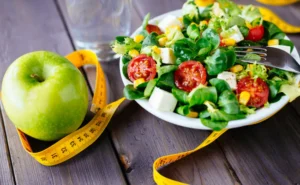Successful weight loss starts in the kitchen, not the gym. While exercise plays an important role in maintaining overall health, research shows that diet accounts for approximately 70% of weight loss results. This is where healthy meal planning becomes your secret weapon for sustainable weight loss success.
Meal planning eliminates guesswork from your daily food choices and helps you stay consistent with your nutrition goals. When you plan your meals ahead of time, you’re less likely to reach for processed foods or make impulsive dining decisions that can derail your progress.
This comprehensive guide will walk you through everything you need to know about creating an effective meal planning strategy for weight loss. You’ll learn how to set realistic goals, choose nutrient-dense foods, and develop sustainable habits that support long-term success.
Understanding the Basics of Healthy Meal Planning
What is Healthy Meal Planning?
Healthy meal planning is the practice of deciding and preparing your meals in advance with a focus on nutritional balance and portion control. It involves selecting recipes, creating shopping lists, and often preparing ingredients or entire meals ahead of time.
For weight loss specifically, meal planning helps you control calorie intake while ensuring you get essential nutrients your body needs to function optimally. This approach prevents the common scenario of feeling hungry and making poor food choices in the moment.
Benefits of Meal Planning for Weight Loss
Strategic meal planning offers numerous advantages for weight loss success:
Calorie Control: Planning meals allows you to calculate and control your daily calorie intake more accurately than spontaneous eating.
Reduced Food Waste: When you plan meals around specific ingredients, you’re less likely to buy unnecessary items that might go bad.
Time Savings: Preparing meals in advance saves time during busy weekdays when you might otherwise opt for fast food or processed options.
Cost Effectiveness: Meal planning typically reduces grocery costs by eliminating impulse purchases and reducing food waste.
Stress Reduction: Knowing what you’re going to eat removes the daily stress of deciding what to cook, especially after a long day.
Step-by-Step Guide to Effective Meal Planning
Set Realistic Goals
Before diving into meal planning, establish clear and achievable weight loss goals. The Centers for Disease Control and Prevention (CDC) recommends losing 1-2 pounds per week for safe, sustainable weight loss.
Consider your current lifestyle, cooking skills, and time constraints when setting goals. If you currently eat out frequently, start by planning to cook at home three times per week rather than attempting to cook every single meal from scratch.
Calculate Calorie Needs
Understanding your daily calorie requirements is crucial for effective meal planning. Your Total Daily Energy Expenditure (TDEE) depends on factors including age, gender, weight, height, and activity level.
To lose weight, you’ll need to create a calorie deficit of approximately 500-750 calories per day to lose 1-1.5 pounds per week. This can be achieved through a combination of reduced calorie intake and increased physical activity.
Online calculators can provide a starting point for determining your calorie needs, but consider consulting with a registered dietitian for personalized recommendations.
Choose Healthy Recipes
Focus on recipes that include whole, minimally processed ingredients. Look for meals that incorporate lean proteins, vegetables, whole grains, and healthy fats. Start with simple recipes that require minimal prep time and gradually work up to more complex dishes as you become comfortable with meal planning.
Create a collection of 10-15 go-to recipes that you enjoy and can prepare efficiently. This prevents meal planning from becoming overwhelming and ensures you always have healthy options available.
Creating a Balanced Meal Plan
Include Lean Proteins
Protein is essential for weight loss because it helps maintain muscle mass, increases satiety, and has a higher thermic effect than carbohydrates or fats. This means your body burns more calories digesting protein compared to other macronutrients.
Excellent lean protein sources include:
- Chicken breast
- Fish and seafood
- Lean cuts of beef and pork
- Eggs
- Greek yogurt
- Legumes and beans
- Tofu and tempeh
Aim to include a protein source in every meal and snack to help control hunger and maintain steady energy levels throughout the day.
Incorporate Healthy Fats
Healthy fats are crucial for hormone production, nutrient absorption, and satiety. They help you feel full and satisfied after meals, reducing the likelihood of overeating.
Include sources of healthy fats such as:
- Avocados
- Nuts and seeds
- Olive oil
- Fatty fish like salmon and mackerel
- Nut butters (in moderation)
Remember that fats are calorie-dense, so portion control is important. A serving of nuts is about a small handful, and a serving of oil is approximately one tablespoon.
Add Complex Carbohydrates
Complex carbohydrates provide sustained energy and important nutrients while helping you feel full. They’re also rich in fiber, which supports digestive health and helps control blood sugar levels.
Choose complex carbohydrates such as:
- Brown rice
- Quinoa
- Sweet potatoes
- Whole grain bread and pasta
- Oats
- Vegetables and fruits
Limit refined carbohydrates like white bread, sugary cereals, and processed snacks, which can cause blood sugar spikes and crashes that lead to increased hunger.
Sample Meal Plan
Here’s a sample daily meal plan that demonstrates balanced nutrition for weight loss:
|
Meal |
Food Items |
Approximate Calories |
|---|---|---|
|
Breakfast |
Greek yogurt with berries and almonds |
300 |
|
Mid-Morning Snack |
Apple with 1 tbsp almond butter |
190 |
|
Lunch |
Grilled chicken salad with mixed vegetables |
350 |
|
Afternoon Snack |
Carrot sticks with hummus |
120 |
|
Dinner |
Baked salmon with roasted vegetables and quinoa |
450 |
|
Evening Snack |
Small portion of mixed nuts |
90 |
|
Total |
1,500 |
This sample plan provides approximately 1,500 calories with a good balance of proteins, healthy fats, and complex carbohydrates. Adjust portion sizes based on your individual calorie needs and activity level.
Tips for Sticking to Your Meal Plan
Prepare Meals in Advance
Meal prep is one of the most effective strategies for maintaining consistency with your meal plan. Dedicate 2-3 hours on weekends to prepare ingredients or complete meals for the upcoming week.
Consider batch cooking proteins like grilled chicken or baked fish, washing and chopping vegetables, and cooking grains in bulk. Store prepared items in portioned containers for easy grab-and-go options throughout the week.
Track Your Progress
Keep a food diary or use a mobile app to track your meals and monitor your progress. This helps identify patterns, ensures you’re meeting your nutritional goals, and provides accountability.
Many apps also track macronutrients and calories, making it easier to stay within your target ranges. Regular tracking helps you make adjustments to your meal plan as needed.
Stay Hydrated
Proper hydration supports weight loss by helping control appetite and supporting metabolic function. Sometimes thirst is mistaken for hunger, leading to unnecessary snacking.
Aim for at least 8 glasses of water per day, and consider drinking a glass before each meal to help with portion control.
Common Pitfalls to Avoid
Setting Unrealistic Goals
One of the biggest mistakes in meal planning is setting overly ambitious goals that are difficult to maintain. Starting with dramatic dietary changes often leads to frustration and abandonment of the plan.
Begin with small, manageable changes and gradually build upon your success. This approach creates sustainable habits that support long-term weight loss.
Not Tracking Calories
While you don’t need to count every calorie forever, tracking intake during the initial stages of meal planning helps you understand portion sizes and calorie content of different foods.
Many people underestimate their calorie intake, which can prevent weight loss progress. Use measuring cups, a food scale, or mobile apps to develop a better understanding of appropriate portions.
Ignoring Nutritional Balance
Focusing solely on calorie restriction without considering nutritional balance can lead to nutrient deficiencies and increased cravings. Ensure your meal plan includes a variety of foods from all food groups.
A balanced approach supports better energy levels, mood stability, and overall health while promoting sustainable weight loss.
Frequently Asked Questions
Q: How much time should I spend on meal planning each week?
A: Most people find that 1-2 hours of planning and 2-3 hours of prep work per week is sufficient. As you become more experienced, this time typically decreases as you develop efficient systems and routines.
Q: Can I still eat out while following a meal plan?
A: Absolutely! Build flexibility into your meal plan by accounting for occasional restaurant meals. Research menu options in advance and choose restaurants that offer healthy options aligned with your goals.
Q: What if I get bored with my meal plan?
A: Variety is key to long-term success. Rotate between different recipes, try new seasonings and cooking methods, and incorporate seasonal produce to keep meals interesting and enjoyable.
Q: Should I plan every single meal and snack?
A: Start with planning main meals and add snacks as needed. Some people prefer to plan everything in detail, while others like flexibility with snacks. Find an approach that works for your lifestyle and preferences.
Q: How do I handle unexpected schedule changes?
A: Build flexibility into your plan by having backup options like frozen vegetables, canned beans, or pre-cooked proteins. Simple meals that can be prepared quickly help you stay on track when life gets busy.
Transform Your Health Through Strategic Planning
Healthy meal planning is a powerful tool for achieving weight loss success, but it requires consistency and patience. The key is finding an approach that fits your lifestyle and preferences while supporting your health goals.
Start small, be flexible, and remember that sustainable weight loss is a gradual process. Focus on creating habits that you can maintain long-term rather than pursuing quick fixes that are difficult to sustain.
By implementing the strategies outlined in this guide, you’ll develop the skills and confidence needed to take control of your nutrition and achieve lasting weight loss success. Remember that every small step forward is progress worth celebrating.
References
- Centers for Disease Control and Prevention. (2022). Losing Weight. Retrieved from https://www.cdc.gov/healthyweight/losing_weight/index.html
- U.S. Department of Health and Human Services and U.S. Department of Agriculture. (2020). 2020-2025 Dietary Guidelines for Americans. Retrieved from https://www.dietaryguidelines.gov/
- National Institute of Diabetes and Digestive and Kidney Diseases. (2021). Healthy Eating & Physical Activity for Life. Retrieved from https://www.niddk.nih.gov/health-information/weight-management/healthy-




